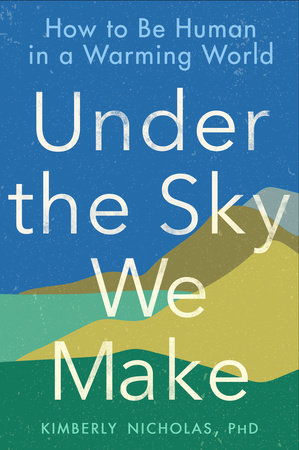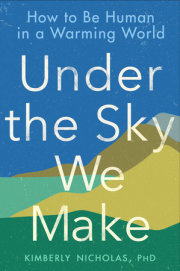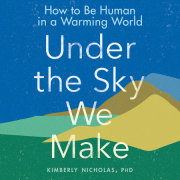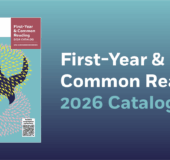Chapter 1
Carbon Is Forever
Understanding the Urgency of the Task Ahead
My mother's mother's mother, Clara, fled what is now Ukraine in 1904, when she was twenty-two. She had sewn her filigreed platinum engagement ring into her jacket to avoid detection as a deserter. If the authorities caught you leaving with your husband, they knew you were escaping for good. Her immigration record from Ellis Island lists her port of departure as Bremen. She and her husband, my great-grandfather Mark, lived in a damp tenement near Coney Island before they eventually settled in Denver, where they ran a women's clothing shop and raised my grandmother Lillian and her brother.
I've seen only one photograph of Mark, wearing a fedora, and Clara, with dark wavy hair. It was taken on a suburban Denver street with my mother, a serious five-year-old, and her sister Judy, already a great beauty at nine: old-world grandparents who loved borscht, posing with their wholly American grandchildren who thought the smell of beets and cabbage cooking was just awful. Clara made her life in a new country in her twenties, as I did in my thirties when I crossed the ocean to live in Sweden.
I never met Clara, but she touches my daily life in two ways. First, her diamond sparkles on my left ring finger. Second, carbon from the coal that powered her escape, across first a continent and then an ocean, is still warming the atmosphere I share today with nearly 8 billion people. Because when your individual actions are powered by fossil fuels, some of the carbon from those actions stays in the air for thousands of years. Your story doesn't end with your death; its contrails unfurl in the physical world for millennia.
Clara lived to be eighty-two-a good, long life. Her grandchildren-my mother and her two siblings-are the last generation of my family to have known her. They're now grandparents themselves. Once they're gone, living memory of Clara will wane and eventually the stories they shared of her will disappear too. Clara's life, as real and as vivid and important as mine or anyone else's, will fade into the background of the human tapestry. But her carbon will outlast us all.
I don't know the name of Clara's mother's mother's mother. She would have been born in black-soil country sometime around 1800, so I can guess that she was part of a big family, all of whom worked hard on the farm. I like to imagine them playing music around the fire at night. But here's one thing I know for sure: A portion of the carbon sent skyward from the wood they burned to stay warm-and the carbon they released plowing the rich black soil-is still in our air today, and it will be for at least the next three hundred generations.
I don't know what Clara was thinking when she decided to risk the perilous journey to a new land and leave behind everything she knew. I don't know how much thought she gave to her potential descendants and the life they would have as a result of her choice, or how much she was motivated by her own more immediate desires. Nevertheless, she set in motion a chain of events that shaped my life, giving me more choices, more freedoms, more privilege. I'm deeply grateful to her as a good ancestor.
Everyone alive today is skywriting the most important legacy of their lives in atmospheric carbon. Long after our names and faces and deeds have faded from living memory, long after any genetic or creative or physical or digital traces of us are gone, this carbon legacy will define us in the minds and stories of our distant descendants. It will literally define the terms of their lives: where they can live, how they can make a living, what kind of civilization and nature surround them. We will be remembered for our carbon legacy by far more people than we'll ever share a meal with or know by name.
Carbon Is Forever
"A diamond is forever." That De Beers clich, in use since 1947, is to a certain extent true. Diamonds are composed of pure carbon. Carbon is the building block of life, found in all known life-forms. Living bodies, from plants to humans, are first and foremost water, which helps regulate temperature, circulate nutrients, and flush waste. But this temporary and variable internal lake drains away to join a new river when we die. What remains is largely carbon. The same carbon atoms have been circulating in a marvelous cycle between air, rocks, soil, water, and living creatures for about half a billion years, since land plants figured out how to turn sunlight and air into humble mosses, then towering trees, greening the earth with the magic of photosynthesis.
How much carbon is in which stage of the cycle largely controls the climate and therefore the habitability of planet Earth. Climate is the long-term average of weather in a particular place. As the saying goes, climate is what you expect; weather is what you get. Carbon in the atmosphere acts like a thermostat. It is the atmospheric level of carbon that primarily determines the temperature to which the planet will eventually heat. When humans burn plants, we put the carbon those plants drew from the air to build their leaves and trunks back in the atmosphere. In the chemical reaction of burning, two oxygen atoms glom on to one carbon atom, forming carbon dioxide. CO2 represents 75 percent of heat-trapping emissions; methane and nitrous oxide make up most of the rest. These greenhouse gases trap heat near the Earth's surface instead of letting it escape into space. This extra heat warms the air and land and upper oceans.
Looking back over time, across the world, continents and oceans sing a coherent chorus: It's warming! The evidence for warming is found in decades of satellite and ocean buoy records; centuries of land thermometer and written records, like Thoreau's Concord journal, from which we know that plants now flower earlier in warmer springs than they did in his time; and millennia of environmental records quietly curated in the bodies of trees and corals and in the pollen lining lake beds. From these ancient records, we know the climate has been relatively stable for the last ten thousand years. Not coincidentally, human civilization was founded and flourished during this benign climate.
Humans have now markedly warmed the world, by approximately 1¡C above its pre-industrial average. Compared with history, today's warming is shockingly fast. A new color scheme, purple, had to be introduced in maps of Australia and the globe to show how much warming has already occurred above the previous end of the scale, red.
We know that today's warming is caused by humans through a combination of observations, theory, and models. Observed measurements show that CO2 has increased 40 percent in the air; enough carbonic acid has been formed from CO2 dissolving in the oceans to increase their acidity 26 percent. Atmospheric measurements sensitive enough to distinguish tiny variations in the global concentration of CO2 pinpoint the source of this carbon from cities and factories. The warming observed is greater over land than over oceans, at higher latitudes, in the upper oceans, and lower in the atmosphere: all consistent with what physics predicts from humans burning carbon on land. Humans have likely caused more than 100 percent of warming to date, because natural trends alone (from variations in the sun and volcanic outputs) would have caused a slight cooling. In short: It's us.
For millennia, essentially the only carbon humans added to the atmosphere came from cutting and sometimes burning plants that grew within their lifetimes ("green" carbon), and from plowing and cultivating soil (a huge library of organic carbon built by generation after generation of decomposed plant roots and leaves). About 30 percent of the cumulative carbon humans have emitted to the atmosphere comes from centuries of transformation of land, clearing vegetation and disturbing soil to raise livestock, grow crops, and harvest timber. Human exploitation of land still causes about a quarter of our total climate pollution, including most methane and nitrous oxide emissions, as I'll cover in Chapter 10.
But the lion's share of greenhouse gas emissions today, including 86 percent of the carbon emitted over the last decade, is created by our burning of ancient plants. This fossil carbon is the 300-million-year-old remnants of lush swamps and sludgy sea-beds (not dinosaurs!), transformed by heat and pressure from the Earth into fossil fuels like coal, oil, and gas. When we burn coal and gas to make electricity and energy to power and heat our homes, and oil to move our cars and planes, that long-buried carbon is transferred from the Earth to the atmosphere. It carries a telltale isotopic signature that definitively identifies it as fossil carbon. And we currently burn a metric shit-ton of prehistoric carbon: 36.8 billion tons of fossil CO2 in 2019, to be exact.
Currently, nature cleans up a bit over half of humanity's carbon mess for free. Slightly more than a quarter of our carbon dioxide becomes plant food for photosynthesis on land. The oceans take up a bit less than a quarter of our carbon, but with a consequence much worse than more trees. Ocean acidification opposes the chemical reaction that the tiny creatures at the foundation of marine food webs use to build their shells out of basic calcium carbonate. The science writer Elizabeth Kolbert likens it to "trying to build a house when someone keeps stealing your bricks." There is a threshold beyond which it is physically impossible for calcium-based shells to form. Reaching it would be disastrous for life in the oceans.
After the land and oceans absorb their share, much of humanity's carbon pollution remains in the atmosphere, driving warming essentially forever. Up to a quarter of the carbon released into the atmosphere today will remain there ten thousand years later, a birthday Stonehenge is slightly more than halfway to reaching, and the Great Pyramids slightly less. Its route out of the atmosphere happens at the unimaginably subtle rate at which raindrops flatten granite mountains, or at which tectonic plates cross oceans, moving about as fast as your fingernails grow. Over millions of years, most of this carbon will end up at the bottom of the ocean, some to eventually be returned to the sky when carbon-rich seafloors push under continental plates, melt to magma, and release their carbon back to the atmosphere when they erupt out of volcanoes.
Before humans showed up, the carbon slowly leaking from rocks to sky via the oceans and volcanoes was balanced by the carbon dissolving from sky to rocks in rainwater. Today, our factories, cars, and other industrial activities emit more carbon in three days than all volcanoes do in a year.
Humans are now adding carbon to the atmosphere hundreds of thousands of times faster than geology can remove it, hence our skyrocketing concentration of airborne carbon. The concentration was around 280 parts per million (ppm) back in the pre-industrial days. It passed 300 ppm for the first time in at least eight hundred thousand years in the early twentieth century, then started rising rapidly after 1950. In 2019, it averaged 411 ppm, rising about 2.3 ppm per year.
The "safe" level is 350 ppm, which we blew past in 1987. Oops.
All this carbon buildup has consequences: Every kilogram added to the atmosphere pushes us toward more dangerous climate change. The carbon math is brutally simple: the more emissions, the more warming, the more harm and suffering.
The Science and Politics of Danger
While the sluggish politics have always lagged far behind the urgent science, stopping warming in time to avoid dangerous climate change has been the central purpose of international climate negotiations for three decades. The objective of the world's first international climate agreement, the 1992 United Nations Framework Convention on Climate Change, and all subsequent ones, including the Paris Agreement, is to achieve "stabilization of greenhouse gas concentrations in the atmosphere at a level that would prevent dangerous anthropogenic [human-caused] interference with the climate system." Danger is defined in terms of three critical priorities that must be protected: healthy ecosystems, food production, and sustainable development. Seems reasonable enough. But of course, nothing is ever easy when it comes to international politics.
A long political process established the temperature goals meant to achieve the purpose of climate stabilization in time to avoid dangerous climate change. In the historic 2015 Paris Agreement, the nations of the world agreed to hold the increase in global average temperatures "well below 2¡C above pre-industrial levels . . . pursuing efforts to limit the temperature increase to 1.5¡C."
The definition of dangerous climate change enshrined in international agreements boils down to a simple affirmation that humans should not screw up the climate so much that it redraws the map for 8 million species and the ecosystems where they live in ways they cannot handle; undermines humanity's ability to feed ourselves if unstable weather wreaks havoc on crops; or erodes the very idea of a stable and prosperous global economy. These sound like pretty darn good ideas. I want to live on a planet where we maintain conditions where nature can survive, humans can grow food, and all people have the opportunity for a good life.
Unfortunately, humans have already caused warming of about 1¡C, and this warming is already undermining each of the three defining priorities a safe climate. I'm sorry to tell you that this means we already live in a world of dangerous climate change.
First, the climate is already changing faster than ecosystems can naturally adapt. The current human-caused increase in CO2 is more than one hundred times faster than the natural variation that happened in the past. Picture strolling along a NASCAR racetrack and trying to keep up with the cars zooming by; keeping up with climate is an even bigger challenge. Some species are running out of options. Gorgeous birds in Hawai'i, including honeycreepers that exist only there, live in the remaining high-elevation forests, where cooler temperatures protect them from mosquitoes and the malaria they carry. As warming brings the shrill whine of the mosquitoes steadily higher, the birds are getting squeezed off the mountaintops toward extinction. Scientists are making desperate attempts at "assisted colonization" to relocate some species and create an "insurance population" to buy more time, but no one thinks this approach will save unraveling ecosystems. Camille Parmesan, who has studied ecosystems under climate change for decades, has found that half of all species studied have had to move in space (range shifts) and two-thirds have moved in time (for example, flowers blooming and birds migrating earlier in the spring) to chase after their niche in a rapidly warming world. These large responses to "only" 1¡C so far are deeply worrying for what's in store under more warming.
Copyright © 2021 by Kimberly Nicholas PhD. All rights reserved. No part of this excerpt may be reproduced or reprinted without permission in writing from the publisher.










